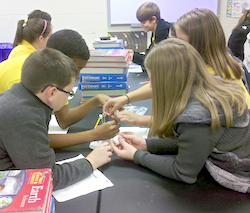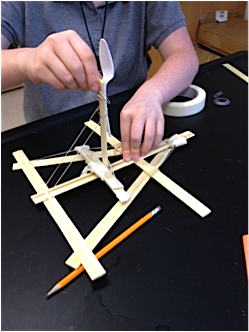A MiddleWeb Blog
 STEM Power! STEM education, driven by learner-centered instruction, provides a powerful learning program for kids. Most students thrive in active, hands-on, problem-solving classroom environments; and this is especially true for kids with special needs.
STEM Power! STEM education, driven by learner-centered instruction, provides a powerful learning program for kids. Most students thrive in active, hands-on, problem-solving classroom environments; and this is especially true for kids with special needs.
Did you know? Many students with special needs actually lean toward STEM fields in higher numbers than other students. According to a STEM3Academy report, about 34% of kids with autism spectrum disorders gravitate to courses and careers involving science, technology, engineering and math. That contrasts with 20% of students in the general school population.
These students often have prolific visual discrimination and pattern recognition skills, plus a single-minded ability to concentrate for extended periods of time and successfully engage in repetitive activities.
 Think bright, eager to learn, andhard-working – this describes many students with special needs. To help them experience STEM success, however, they need certain supports and accommodations. Nina Fiore, inFocus On Abilities and Benefit All Children: A Case for Progressive... identifies some supports these students need. Not surprisingly, STEM classes naturally provide some of those needed supports.
Think bright, eager to learn, andhard-working – this describes many students with special needs. To help them experience STEM success, however, they need certain supports and accommodations. Nina Fiore, inFocus On Abilities and Benefit All Children: A Case for Progressive... identifies some supports these students need. Not surprisingly, STEM classes naturally provide some of those needed supports.
- Regular movement. STEM classes depend on active, hands-on engagement to solve real world problems. Opportunities for purposeful movement abound.
- Shorter class times. Actually, STEM class time is not shorter; however, there are built-in stopping and starting points as students move through the engineering design process. This provides breaks and time for kids to process what they are learning and doing.
- Smaller classes. Teams of 4 to 6 students are the norm for well-designed STEM classes. While the class may contain a normal number of students, kids work primarily in small group settings.
- Respectful, understanding environments. STEM classes are safe spaces. If a team fails to create a workable solution for a problem, no sweat. It’s just a normal step in improving the design and succeeding. Ideally, team members show respect and accept one another, and teachers monitor teams as they work to see that this is happening.
- Flexible teaching styles. STEM is the ultimate exercise in teaching flexibility. Project-based learning and inquiry approaches drive student learning.
Think about it – what students would not benefit from those built-in STEM “accommodations?” STEM is a win-win situation for students with special needs and their friends.
Special Needs Teaching Strategies
How can STEM teachers prepare for and teach students with special needs? Here’s a brief, how-to list of strategies that can actually be valuable for all students.
- Assume competency. Believe that students with special needs can learn at higher levels and that you can create an environment to help them do that.
- Build on students’ strengths and interests. Leverage their strong points to increase their comfort and excitement about learning.
- Use a “flow learning” approach. Clearly define the purpose of their STEM challenge. Set the challenge level high and make sure your students with special needs will have opportunities to be successful with that challenge. Provide clear and immediate feedback so they can change and adapt as needed.
 http://www.middleweb.com/wp-content/uploads/2016/02/students-7.png 249w" sizes="(max-width: 210px) 100vw, 210px" />Make use of assistive technology tools when needed. Technology can support students with special needs, especially if they have hearing or visual losses. Provide handouts and written materials in a digital format for these students.
http://www.middleweb.com/wp-content/uploads/2016/02/students-7.png 249w" sizes="(max-width: 210px) 100vw, 210px" />Make use of assistive technology tools when needed. Technology can support students with special needs, especially if they have hearing or visual losses. Provide handouts and written materials in a digital format for these students.- Focus on safety consideration Be especially alert for safety issues when students are working with equipment to design devices for solving their problem.
- Model persistence, communication, creativity, and collaboration. These qualities are especially useful to kids with special needs who may need help with social skills.
- Establish collaborative student teams. That’s a tall order but stick with it all year. Be intentional. Help students understand that respect and inclusiveness are non-negotiable behaviors for all teams. Teammates honor one another’s strengths and accept each other’s differences. Give them specific strategies for showing respect through speech and actions. Teamwork allows special students to practice social skills they will need throughout life.
Note: For specific suggestions in making appropriate accommodations for a variety of special needs, you might want to peruse this online book: Accommodating Students with Disabilities in Science, Technology, En... by Nathan W. Moon et al.
Special Needs Challenges
By now you know that teaching any group of students is both rewarding and challenging. Approach your students with special needs with high expectations, but don’t adopt a Pollyanna mindset. You’ll encounter plenty of challenges. For some students, the science and math content may be beyond their current learning level. The pace of the lesson may be difficult for some to keep up. Some students will want to work alone instead of in teams.
 Noise levels in the class may distract and annoy some students. Busy visual stimulation on classroom walls may distract others. Social expectations may frustrate students with special needs. So what do you do?
Noise levels in the class may distract and annoy some students. Busy visual stimulation on classroom walls may distract others. Social expectations may frustrate students with special needs. So what do you do?
Get to know your students with special needs. Work together with their special education teachers and learn as much as you can about their strengths and difficulties. You’ll find many ways to make reasonable accommodations.
You might use images and graphics to make handouts clearer, headphones for those distracted by noise, a break zone or a quiet space, and technology that enlarges print. Your special education teaching colleagues will be your most valuable resource as you plan for and include these students in your STEM lessons.
The unique design of STEM lessons allows students, regardless of disability, access to the real-life learning experiences. Give these students with special needs STEM experiences to help them get ready for a future society where all types of people live and work together seamlessly.
This post provided a quick overview of a vitally important topic. You might want to learn more by examining these resources. Please share additional resources and tips in the Comments section.
- Accommodating Students with Disabilities in Science, Technology, En...
- National UDL Center: Alternatives for STEM Visual Information
- Inclusive Education in STEM
- Makerspaces for Students with Special Needs
- Meeting the Needs of Students with Disabilities in a STEM School
- Special Needs and STEM
- STEM and Special Needs
You need to be a member of School Leadership 2.0 to add comments!
Join School Leadership 2.0